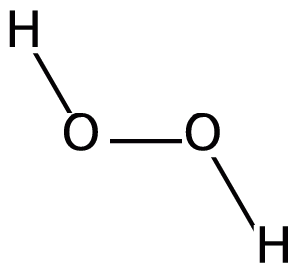Hydrogen peroxide

Hydrogen peroxide is a chemical compound. Its molecular formula is H2O2. It is used as a cleaner, and as hair bleach. In a concentration of 3% (meaning that there are 3 grams of hydrogen peroxide for 100 grams of a water solution), it can be used to treat wounds. Over time, it will slowly become oxygen gas and water through decomposition.
Chemists often use hydrogen peroxide in chemical reactions. It is a very strong oxidising agent when used with acid and water. Oxidising agents take electrons from other compounds.
- 2 Fe2+ (aq) + H
2O
2 + 2 H+
(aq) → 2 Fe3+ (aq) + 2 H
2O (l)
Here hydrogen peroxide takes an electron from the Fe2+ ions and becomes water. The iron is oxidised (loses electrons) to the Fe3+ ion.
It can also be a reducing agent when used with stronger oxidisers like sodium hypochlorite. When it acts as a reducing agent, oxygen gas is also produced. Reducing agents give electrons to other compounds. This method is often used to make oxygen in laboratories.
- NaOCl + H
2O
2 → O
2 + NaCl + H
2O
Hydrogen peroxide can be bought in shops when mixed with lots of water but is very dangerous when the concentration is higher. Because it is an oxidiser, it can cause flammable materials to ignite.
Hydrogen Peroxide Media
Phase diagram of H
2O
2 and water: Area above blue line is liquid. Dotted lines separate solid–liquid phases from solid–solid phases.Catalytic cycle for the anthraquinone process to produce hydrogen peroxide: an anthraquinone (right) is reduced using hydrogen to produce the corresponding anthrahydroquinone (left). This is oxidized using oxygen to produce hydrogen peroxide and recover anthraquinone.
Australian bombardier beetle
Rocket-belt hydrogen peroxide propulsion system used in a jet pack
Contact lenses soaking in a 3% hydrogen peroxide-based solution. The case includes a catalytic disc which neutralises the hydrogen peroxide over time.
Chemiluminescence of cyalume, as found in a glow stick










